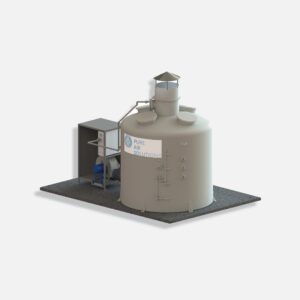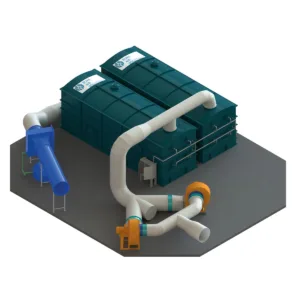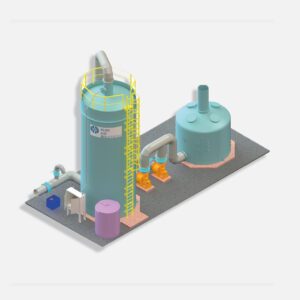Introduction:
In the industrial landscape, controlling and mitigating odors is a paramount concern for both operational efficiency and environmental responsibility. Unpleasant odors not only affect the well-being of employees but also impact surrounding communities. Choosing the right odor control system for industrial purposes demands a strategic approach. This comprehensive guide will walk you through key considerations to ensure you select a solution that aligns with your industrial needs.
Key Considerations:
Identify the Nature and Source of Odors:
Begin by conducting a thorough assessment of the industrial facility. Identify the specific processes or activities that contribute to odor emissions.
Categorize odors based on their origin, whether from manufacturing processes, chemical reactions, or waste management.
Understand Industrial Odor Control Technologies:
Familiarize yourself with the various odor control technologies available for industrial applications.
Consider options such as a. Chemical Scrubbers: Use chemicals to neutralize odorous compounds. b. Biofiltration: Utilize microorganisms to break down and eliminate odor-causing compounds. c. Adsorption: Deploy materials like activated carbon to capture and neutralize odor molecules. d. Thermal Oxidizers: Apply high temperatures to combust odorous compounds. e. Combining Technologies: In some cases, a combination of technologies may provide optimal results.
Evaluate System Capacity and Efficiency:
Assess the scale of odor emissions and the required coverage area. Choose a system with the capacity to treat the entire industrial space effectively.
Evaluate the efficiency of the selected technology in terms of odor removal and the specific compounds it can address.
Consider Environmental Impact:
Prioritize environmentally sustainable solutions. Some odor control systems may produce by-products or emissions that can have secondary effects on air and water quality.
Opt for technologies that align with your company’s environmental policies and adhere to regulatory standards.
Assess Operational and Maintenance Requirements:
Evaluate the operational demands and maintenance requirements of each odor control system.
Consider factors such as energy consumption, water usage, and ongoing maintenance to ensure the chosen system is practical for industrial settings.
Ensure Regulatory Compliance:
Familiarize yourself with local and national regulations governing industrial odor emissions.
Ensure that the selected odor control system complies with these regulations to avoid legal complications and maintain a positive relationship with regulatory authorities.
Cost-Effectiveness and Return on Investment (ROI):
While cost is a significant factor, consider it in the context of long-term benefits and return on investment.
Factor in installation costs, operational expenses, and potential savings from improved efficiency and regulatory compliance.
Customization and Adaptability:
Choose a system that can be customized to fit the specific needs of your industrial processes.
Consider the system’s adaptability to accommodate changes in production or facility layout.
Types of odor control technologies:
With a multitude of odor control technologies available, selecting the right one can be a daunting task. In this guide, we’ll compare different odor control technologies, helping you make an informed decision based on your specific needs and preferences.
Chemical Scrubbers:
How it Works: Chemical scrubbers use liquid solutions or chemicals to react with and neutralize odor-causing compounds.
Pros:
Effective for a wide range of odorous compounds.
Applicable in both industrial and commercial settings.
Cons:
Consumes chemicals, leading to ongoing operational costs.
Maintenance requirements for chemical replenishment.
Biofiltration:
How it Works: Biofiltration employs microorganisms to break down and eliminate odor-causing compounds through biological processes.
Pros:
Environmentally friendly and sustainable.
Effective for organic odorous compounds.
Cons:
Requires regular monitoring and maintenance of microbial populations.
May have limitations in treating certain inorganic compounds.
Adsorption:
How it Works: Adsorption technologies use materials like activated carbon to capture and neutralize odor molecules.
Pros:
Versatile and effective for various odorous compounds.
Can be applied in both air and water treatment.
Cons:
Regular replacement or regeneration of adsorption materials is necessary.
Limited lifespan of adsorption materials.
Thermal Oxidizers:
How it Works: Thermal oxidizers apply high temperatures to combust odor-causing compounds, converting them into less odorous by-products.
Pros:
High efficiency in destroying odorous compounds.
Suitable for a wide range of industries.
Cons:
Energy-intensive, leading to high operational costs.
Limited applicability for certain compounds.
Ozone Generators:
How it Works: Ozone generators produce ozone, a powerful oxidizing agent, to neutralize odorous compounds.
Pros:
Effective for various odor sources.
Acts as a disinfectant, reducing microbial activity.
Cons:
Ozone can be harmful to human health in high concentrations.
Limited effectiveness for certain compounds.
Vapor Phase Technologies:
How it Works: Vapor phase technologies release neutralizing agents in vapor form to combat odors.
Pros:
Can be applied in both industrial and commercial settings.
Provides continuous, long-term odor control.
Cons:
Effectiveness may vary based on environmental conditions.
May require a consistent supply of neutralizing agents.
Comparative Analysis:
Effectiveness: Assess the efficiency of each technology in neutralizing the specific odorous compounds present in your environment.
Environmental Impact: Consider the ecological footprint, emissions, and by-products associated with each technology to ensure it aligns with sustainability goals.
Operational Costs: Evaluate ongoing operational expenses, including energy consumption, chemical usage, and maintenance requirements, to determine the long-term cost-effectiveness.
Applicability: Choose a technology that suits the scale and nature of your facility, considering factors such as coverage area, airflow, and adaptability to changing conditions.
Conclusion:
Selecting the right odor control system for industrial purposes is a strategic decision that requires a holistic approach. By understanding the nature of odor emissions, exploring available technologies, and considering factors such as efficiency, environmental impact, compliance, and cost-effectiveness, industrial facilities can implement a solution that not only addresses odor challenges but also contributes to a safer, healthier, and more sustainable working environment. Invest in the right odor control system to ensure your industrial operations are both efficient and responsible.






